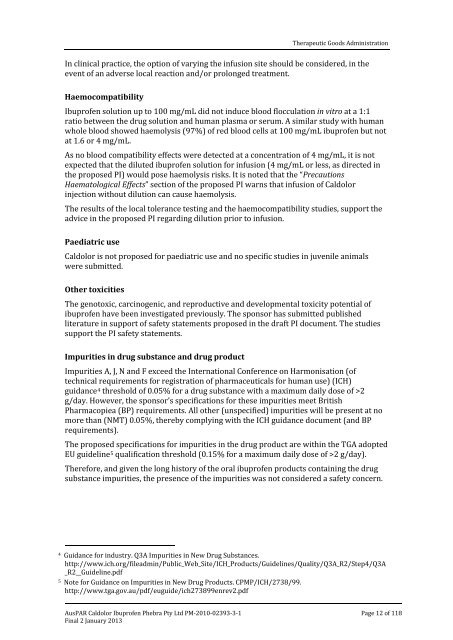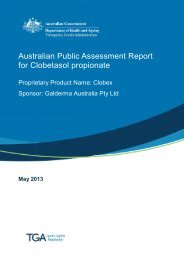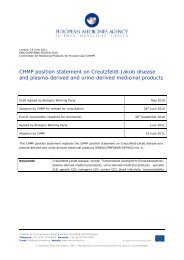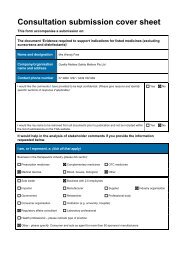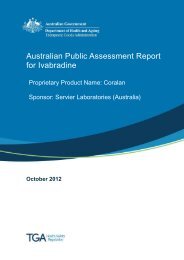Australian public assessment for Ibuprofen - Therapeutic Goods ...
Australian public assessment for Ibuprofen - Therapeutic Goods ...
Australian public assessment for Ibuprofen - Therapeutic Goods ...
You also want an ePaper? Increase the reach of your titles
YUMPU automatically turns print PDFs into web optimized ePapers that Google loves.
AusPAR Caldolor <strong>Ibuprofen</strong> Phebra Pty Ltd PM-2010-02393-3-1<br />
Final 2 January 2013<br />
<strong>Therapeutic</strong> <strong>Goods</strong> Administration<br />
In clinical practice, the option of varying the infusion site should be considered, in the<br />
event of an adverse local reaction and/or prolonged treatment.<br />
Haemocompatibility<br />
<strong>Ibuprofen</strong> solution up to 100 mg/mL did not induce blood flocculation in vitro at a 1:1<br />
ratio between the drug solution and human plasma or serum. A similar study with human<br />
whole blood showed haemolysis (97%) of red blood cells at 100 mg/mL ibuprofen but not<br />
at 1.6 or 4 mg/mL.<br />
As no blood compatibility effects were detected at a concentration of 4 mg/mL, it is not<br />
expected that the diluted ibuprofen solution <strong>for</strong> infusion (4 mg/mL or less, as directed in<br />
the proposed PI) would pose haemolysis risks. It is noted that the “Precautions<br />
Haematological Effects” section of the proposed PI warns that infusion of Caldolor<br />
injection without dilution can cause haemolysis.<br />
The results of the local tolerance testing and the haemocompatibility studies, support the<br />
advice in the proposed PI regarding dilution prior to infusion.<br />
Paediatric use<br />
Caldolor is not proposed <strong>for</strong> paediatric use and no specific studies in juvenile animals<br />
were submitted.<br />
Other toxicities<br />
The genotoxic, carcinogenic, and reproductive and developmental toxicity potential of<br />
ibuprofen have been investigated previously. The sponsor has submitted published<br />
literature in support of safety statements proposed in the draft PI document. The studies<br />
support the PI safety statements.<br />
Impurities in drug substance and drug product<br />
Impurities A, J, N and F exceed the International Conference on Harmonisation (of<br />
technical requirements <strong>for</strong> registration of pharmaceuticals <strong>for</strong> human use) (ICH)<br />
guidance 4 threshold of 0.05% <strong>for</strong> a drug substance with a maximum daily dose of >2<br />
g/day. However, the sponsor’s specifications <strong>for</strong> these impurities meet British<br />
Pharmacopiea (BP) requirements. All other (unspecified) impurities will be present at no<br />
more than (NMT) 0.05%, thereby complying with the ICH guidance document (and BP<br />
requirements).<br />
The proposed specifications <strong>for</strong> impurities in the drug product are within the TGA adopted<br />
EU guideline 5 qualification threshold (0.15% <strong>for</strong> a maximum daily dose of >2 g/day).<br />
There<strong>for</strong>e, and given the long history of the oral ibuprofen products containing the drug<br />
substance impurities, the presence of the impurities was not considered a safety concern.<br />
4 Guidance <strong>for</strong> industry. Q3A Impurities in New Drug Substances.<br />
http://www.ich.org/fileadmin/Public_Web_Site/ICH_Products/Guidelines/Quality/Q3A_R2/Step4/Q3A<br />
_R2__Guideline.pdf<br />
5 Note <strong>for</strong> Guidance on Impurities in New Drug Products. CPMP/ICH/2738/99.<br />
http://www.tga.gov.au/pdf/euguide/ich273899enrev2.pdf<br />
Page 12 of 118


